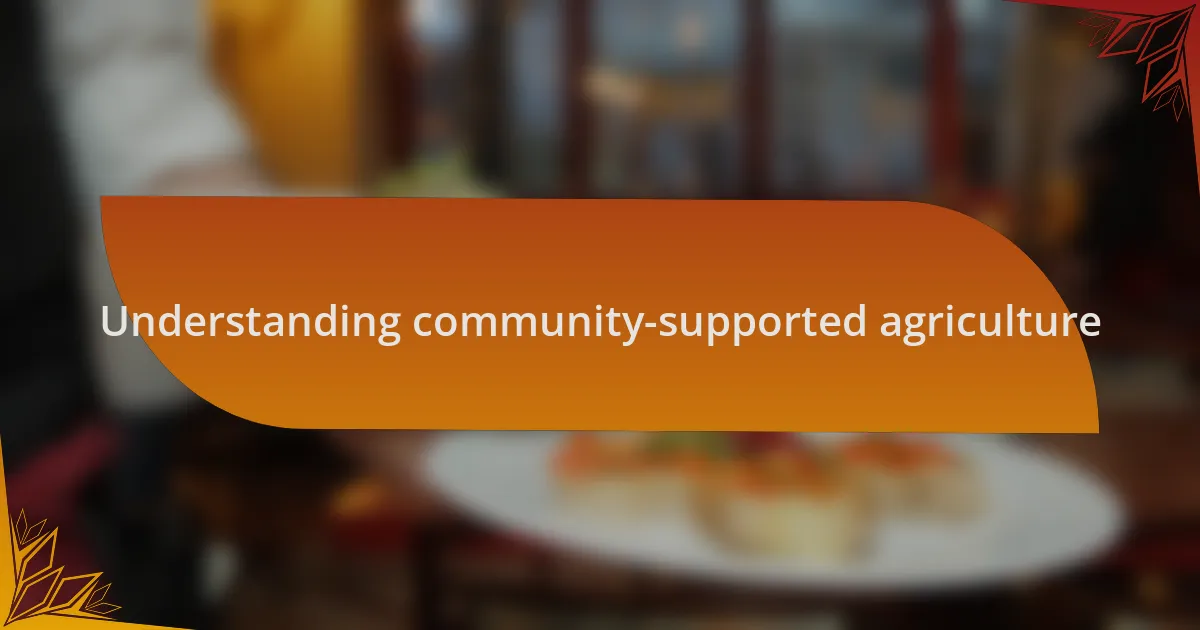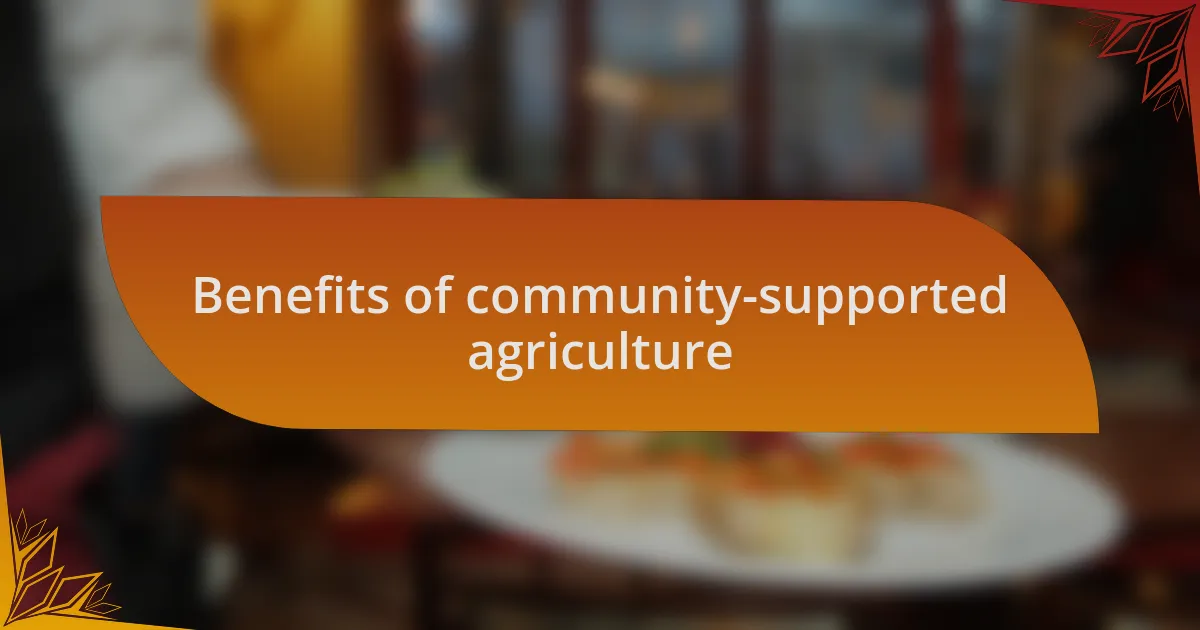Key takeaways:
- Community-supported agriculture (CSA) fosters connections between consumers and local farmers, enhancing food appreciation and community bonds.
- CSAs provide fresher produce, reduce carbon footprints, and offer a variety of seasonal ingredients that enrich culinary experiences.
- Green restaurants prioritize sustainability through local sourcing, waste reduction, and transparency, ensuring informed dining choices.
- Building relationships with local farmers enhances dining experiences by creating unique menu opportunities and fostering commitment to sustainable practices.

Understanding community-supported agriculture
Community-supported agriculture (CSA) is a system that connects consumers directly with local farmers, allowing individuals to purchase shares of the harvest. I remember the excitement I felt when I first opened a box of fresh, seasonal produce from my local CSA. Each week brought surprises that not only delighted my taste buds but also deepened my appreciation for the hard work and dedication that goes into sustainable farming.
Participating in a CSA often makes consumers feel like part of a community, fostering relationships between eaters and growers. Have you ever considered how it feels to know the person who cultivated your food? It transforms eating from a mundane task into a more meaningful experience, as you develop a connection to the land and the people behind your meals.
Moreover, CSAs can significantly impact food security and promote local economies. When I learned that my investment helped sustain family farms in my area, I felt a sense of pride in supporting local agriculture instead of large corporations. This approach not only benefits farmers but also helps promote biodiversity, making our food systems more resilient and sustainable.

Benefits of community-supported agriculture
The benefits of community-supported agriculture are numerous, but one that stands out for me is the freshness of the produce. When I bite into a ripe tomato from my local CSA, it bursts with flavor in a way that store-bought tomatoes simply can’t compete with. Have you ever noticed how supermarket fruits often taste bland? That’s because they are picked long before they ripen to withstand transport, whereas CSA produce is harvested at its peak.
Another significant advantage is the environmental impact. I often marvel at the reduced carbon footprint associated with locally sourced food. By cutting out the middleman and shortening transportation distances, CSAs not only provide delicious produce but also promote sustainable practices. It makes me feel good knowing my food choices are contributing positively to the planet.
Lastly, being part of a CSA has introduced me to a variety of vegetables I would have never tried otherwise. Each season, I receive unique items that challenge my culinary skills and broaden my palate. Have you thought about how trying new foods can enhance your cooking? It certainly keeps meal planning exciting and helps me create more diverse dishes, turning my kitchen into a place of exploration rather than routine.

Principles of green restaurants
Green restaurants prioritize sustainability, focusing on minimizing their environmental impact while maximizing their community engagement. For instance, I recall visiting a local green restaurant that sourced its ingredients from nearby farms. The owners passionately shared stories of the farmers, creating a profound connection between the meal and the land it came from. Have you ever felt that sense of responsibility when dining out, knowing your choices support local businesses?
Another key principle is waste reduction. I’ve seen green restaurants implement innovative practices, like composting kitchen scraps and using biodegradable packaging. One memorable visit included a thoughtful explanation of how they repurpose food waste into delicious broths. This creativity not only reduces waste but also enhances the overall dining experience. It really makes you think about how every component of the meal can contribute to a sustainable footprint, doesn’t it?
Transparency in sourcing is also crucial. I appreciate how many green restaurants openly share where their ingredients come from, encouraging patrons to ask questions. This transparency fosters trust and empowers diners to make informed choices. I remember a time when a server enthusiastically detailed the journey of a dish from farm to table, and it sparked a delightful conversation among guests. Doesn’t it feel good to know that your meal has a story worth sharing?

Choosing local suppliers for ingredients
Choosing local suppliers for ingredients isn’t just a business decision; it’s a heartfelt commitment to supporting the community. I remember when I first started visiting a restaurant that sourced its produce from a nearby farmer’s market. The vibrant colors of the vegetables and the freshness of the herbs were palpable, igniting a joy I hadn’t felt before when dining out—there’s something incredibly satisfying about knowing that your meal is a product of local effort and dedication.
When selecting local suppliers, I’ve learned that it’s essential to build relationships with these farmers. One restaurant I adore even invited a farmer to their kitchen for a special event, allowing diners to interact directly with the person who grew their food. Such moments create powerful connections, enhancing not just the meal but the entire dining experience. Have you ever considered how those personal touches can transform a simple dinner into a memorable event?
Moreover, choosing local ingredients often leads to a more sustainable menu, reducing the carbon footprint associated with transportation. I recall a lovely dinner at a farm-to-table restaurant where the chef detailed how seasonal sourcing influences the menu. It made me reflect on how our dining habits could play a part in protecting the environment. Doesn’t knowing that your meal is helping the planet increase your appreciation for every bite?

Building relationships with local farmers
Building relationships with local farmers is truly about connection and collaboration. I recall visiting a local farm where the farmer eagerly shared stories about the challenges of growing organic produce. Their passion was contagious, and I realized that when restaurants embrace these relationships, it enriches our dining experience and fosters genuine support for the local economy. Have you ever thought about how those stories give a face to the food on your plate?
Engaging with farmers also opens the door to unique menu opportunities. One time, during a visit to a lavender farm, the farmer suggested using fresh lavender in cocktails, sparking a whole new seasonal drink menu at a nearby restaurant. This exchange not only brought something special to the menu but also deepened the bond between the restaurant and the farm. Isn’t it fascinating how simple conversations can lead to innovative culinary creations?
Furthermore, nurturing these partnerships creates a platform for dialogue about agricultural practices and sustainability. I attended a local food festival where chefs and farmers spoke openly about the importance of sustainable farming methods. Their shared commitment to preserving the land made me reflect on how interconnected we all are in this journey towards greener eating. Have you felt that sense of community when you learn about the origins of your food?

Personal experiences with community-supported agriculture
Sharing in a community-supported agriculture (CSA) program has been a transformative experience for me. The moment I picked up my first box of fresh, organic vegetables, I felt a sense of excitement akin to opening a present. Each item was a surprise, and it reminded me of the time when I was a child, eagerly awaiting the harvest from my grandmother’s garden. Have you ever felt that joy when connecting with your food?
One afternoon, I decided to host a dinner party featuring ingredients exclusively sourced from my CSA. As I prepared the dishes, I found myself reflecting on the farmers’ dedication and how each ingredient had its own story. My guests were not just tasting food; they were tasting the essence of our local community. It made me wonder, how often do we get to experience food that carries such a personal touch?
Additionally, my involvement in CSA has helped me develop a deep appreciation for seasonal eating. Last summer, I was introduced to an abundance of heirloom tomatoes, something I had never really explored before. This experience taught me not only about the diversity of flavors available but also about the importance of eating in harmony with nature’s cycles. Can you recall a time when you discovered a new ingredient that opened your eyes to the possibilities of cooking?